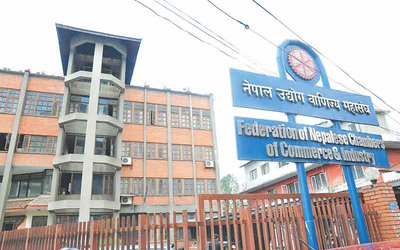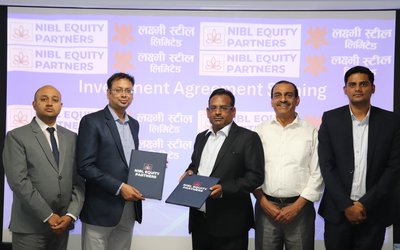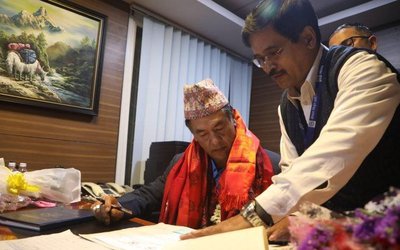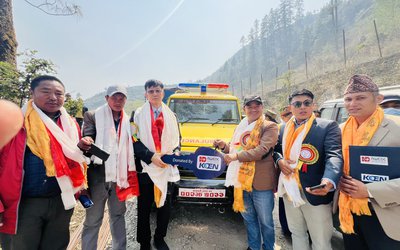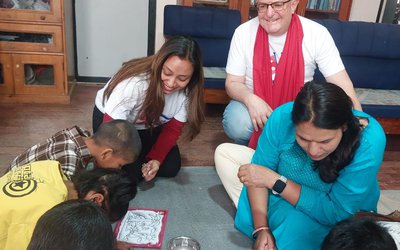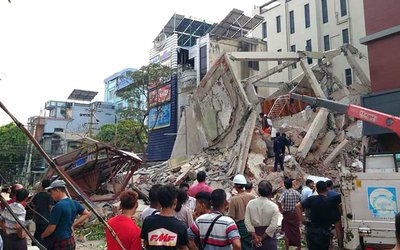
Thir Bahadur Tamang, 48, a resident of Mangaltar Village Development Committee, had never realized that by selling green vegetables, he could make a huge amount of money for his family. Under subsistence farming for a long time, farmers like Tamang had never thought about the commercial prospects of agriculture.
After his village got connected to capital Kathmandu and Madhesh through Sindhuli Road, Tamang and his neighbors had reasons to rejoice. The road has not only reduced travelling time to Banepa and Bardibas but also helped the villagers explore prospects to improve their livelihood through the commercialization of agriculture.
To support the farmers, JICA has also launched programs in commercialization of agriculture. With motor vehicle starting to roll on the road, farmers came out with their vegetable products for various markets.
“JT and JTA are coming to us with seeds and training packages. With the road, we are also getting high value seeds from the District Agriculture Development Office,” said Tamang.“Farmers are planting various kinds of vegetables to supply to the market in Kathmandu,” said Tamang, father of three children. "I don’t have to go for work outside my village after planting the vegetables."
The road which touches four districts Kavre, Sindhuli, Ramechhap and Bardibas is also giving benefits to farmers living in Dolakha and Okhaldhunga. JICA is also supporting programs in some areas of Dolakha and Ramechhap.
The road project is a major achievement as it provides an alternative link to Kathmandu and southern plains. It also promises to contribute to accelerate the economic activities in the region.
Following the inauguration of the road, the number of people travelling from the eastern part of Nepal has drastically increased. Shortening the time of travel by half, the private sector operators are running minibuses to connect eastern cities to Kathmandu.
The road also links the eastern parts of Nepal like Udayapur, Okhaldhunga, Khotang and Solukhumbu through the Middle Hills Highway. SRN has started as a support for poverty reduction and improvement of road network in Terai Plain and middle hills.
With JICA's technical support, high value agricultural products were introduced along the Sindhuli Road and to bring the profit to the people concerned, particularly small farmers. Started in 1995, the road construction completed last year.
As the road passes through the low valley of Rosi and Sunkosi Rivers before rising up to the Mahabharat and reaching Sindhuli, there are many areas along the meandering road where climate is favorable for the vegetables. Generally, the high hills are favorable for horticulture.
JICA is providing support to the farmers under Sindhuli Road Corridor Commercial Agriculture Promotion Project (SRC-CAP) under the department of Agriculture. Like Tamang many other small farmers living in Kavre, Sindhuli, Ramechhap and Mahotari are getting the benefit.
According JICA, the project aims to develop the value chain of high value agriculture products in the areas along the Sindhuli Road. With the implementation of agriculture commercialization, agriculture income of the farm households in the Sindhuli Road Corridor (SRC) area has increased. Value chains of high value commodities (HVCs) function to bring stakeholders profit along road corridor.
“The project is now implemented in Bhadrakali VDC 4, 8, 9, Jalkanya VDC 2 of Sindhuli , Bhimeshowr VDC 7, 8, 9, Ramechhap Gelu VDC 1 , Fulasi VDC 1, Bhimeshowr Municipality 1 and Melung VDC 1 of Dolakha and Dhulikhel Municipality 10, 11, 12, Katunjebesi 4, 5 Mangaltar 7, 9 VDC of Kavre,” said a press release by JICA.
The project also supports identifying potential buyers and suppliers to implement program and basic farm data collection. Through the DADO and JTs and JTAs, the project also provides basic training for farmers in four districts.
Along with providing technical support, it also provides training and help in searching for the markets. JICA is now providing farmers to develop the market oriented agriculture.
Like Tamang, people along the highway are motivated to grow the vegetables because there is the market. “The overall goal is that agricultural income of the farm households in the Sindhuli Road Corridor (SRC) area is increased through agricultural commercialization,” said JICA’s press notes.
The purpose of the project is creating value-chains for high value commodities (HVCs) whose function is to bring stakeholders profit along SRC. Capacity of the producer groups is developed to sustain marketing of the marketable product.
“JICA supported project has transformed the livelihood of people, particularly poor and vulnerable communities of the areas,” said Director General of Department of Agriculture Development. "After the completion of the project, the entire corridor areas will transform into a hub for agriculture products.”
“Skills and capacity of the counterpart agencies for implementation and coordination of the project conducted for agricultural commercialization promotion are improved skills and capacity of Department of Agriculture (DOA)/ District Agriculture Development Office (DADO) for implementation and coordination of agricultural commercialization promotion are improved same,” said JICA.
Along with selecting sites and producer groups for the project activities, the project also supports baseline survey to be implemented by the producer groups and JT/JTAs in DADO. It provides basic training for production of the marketable products to the producer groups.
It also provides specific training for target marketable products to the producer groups, supports implementation of the action plan formulated by the producer groups, conducts end-line survey of the data collected by 1-2 and analyzes outputs.
It organizes a meeting of the producer groups and the horticulture related traders for promoting market oriented farming such as Matching Forum, etc.
The project provides basic training for marketing of the marketable products to the producer groups and supports market survey which is implemented by the producer groups.
As market is necessary for the commercialization of agriculture, it encourages communication between the producer groups and the horticulture related traders for concluding business negotiations. The project also supports the producer groups in solving the problems that occur during the marketing their products.
As many organizations are involved in the process, the project also coordinates activities in relation to agricultural commercialization promotion with other departments in DOA. Realizing the importance of monitoring, the project supports periodical site monitoring and evaluation of the producer group’s activities to be conducted by the JT/JT.
Follow up is another important part of this project. It supports implementation of periodical meetings of District Progress Review Committee with district level stakeholders. Implementing an annual meeting of Project Progress and Review Committee at central level chaired by DOA with attendance of related stakeholders, issues on promoting agricultural commercialization are clarified.
As Sidhuli road received JICA President Award for quality of road, this is a model road project not only to shorten the distance between Kathmandu and plains but also to help improve the livelihood of people through commercialization of agriculture.
In the last sixty years of establishment of bilateral relations, Sindhuli Road Project has stood out as a model to show how commercialization of agriculture uplifts the life of poor and vulnerable people.

Keshab Poudel
Poudel is the editor of New Spotlight Magazine.
- FM Dr. Deuba’s India Visit: Mission Aborted
- Mar 26, 2025
- AMBASSADOR MAEDA TORU: Warm Regards
- Mar 24, 2025
- PRO-MONARCHY MOVEMENT: Rising Dissatisfaction
- Mar 23, 2025
- Dr. PRABIN MANANDHAR: Person With Humility
- Mar 16, 2025
- US SUSPESION OF GRANT: Impact On Nepal
- Mar 10, 2025

